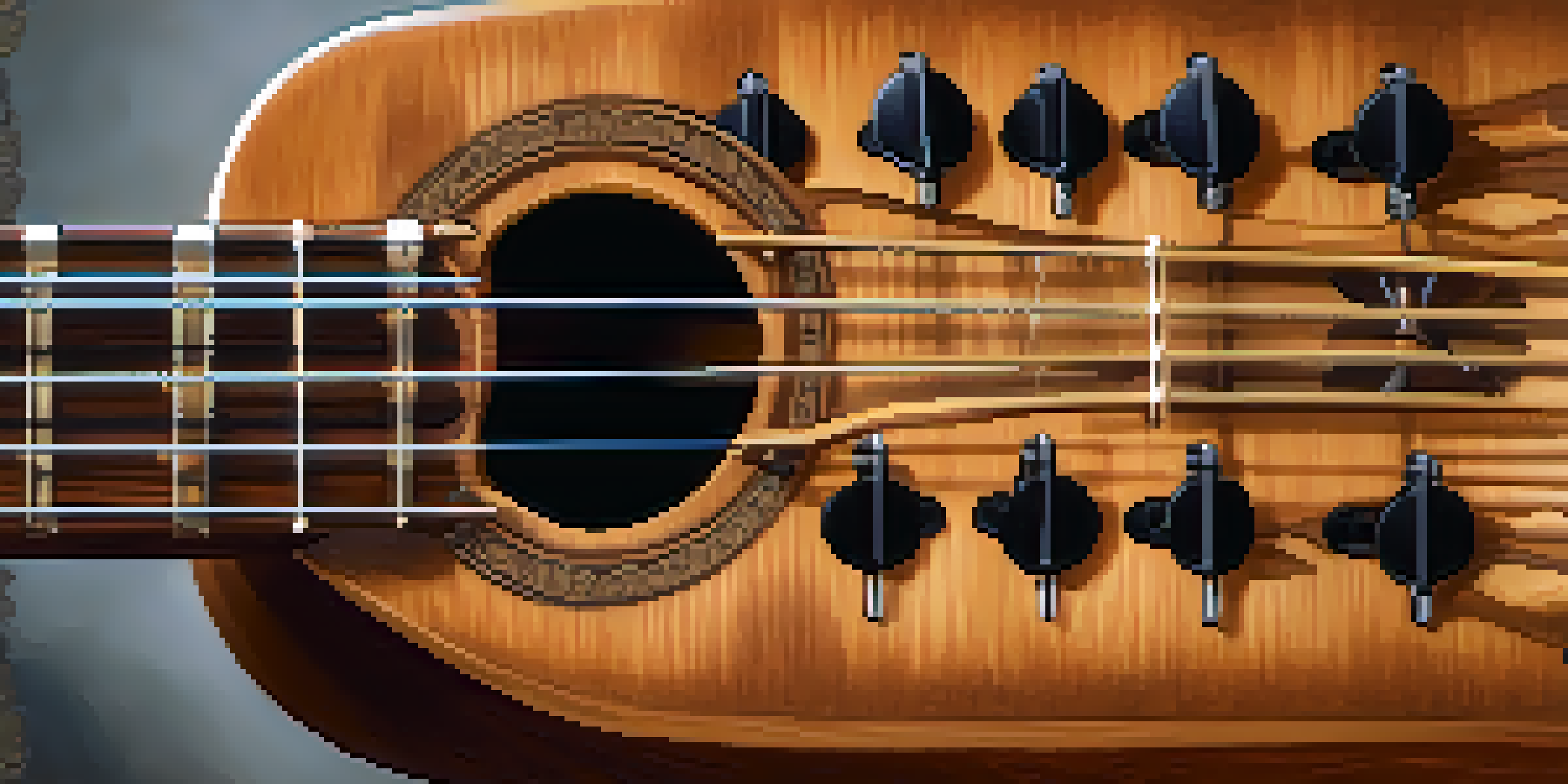The Headstock of a Ukulele: Tuning Mechanisms Explained

What is the Headstock of a Ukulele?
The headstock is the top part of a ukulele, where the tuning pegs are located. It plays a crucial role in the instrument's functionality, as it holds the strings and allows you to adjust their tension. This adjustment is essential for tuning the ukulele to the correct pitch, which is vital for producing harmonious sounds.
Tuning is the foundation of music; without it, the notes are just noise.
Usually made of wood or a combination of materials, the headstock can vary in design. Some ukuleles feature a traditional paddle shape, while others may have more elaborate designs that showcase craftsmanship. Regardless of its appearance, the headstock's primary purpose remains the same: to facilitate tuning.
Understanding the headstock's role helps ukulele players appreciate their instrument better. It's not just a decorative element; it's a fundamental component that directly influences how the ukulele sounds and performs.
The Role of Tuning Pegs in Ukuleles
Tuning pegs, also known as tuning machines or tuners, are the small knobs located on the headstock that you turn to adjust string tension. Each string on the ukulele has its own tuning peg, allowing for precise tuning of each string individually. This means you can easily achieve the correct pitch for standard tuning or any alternate tuning you prefer.

The mechanism behind these pegs usually involves a gear system that provides a firm grip on the string when the peg is tightened. This design ensures that once you’ve tuned the string, it stays in place until you decide to adjust it again. Therefore, good quality tuning pegs can greatly improve your playing experience.
Understanding the Ukulele Headstock
The headstock is essential for tuning, holding the strings and allowing adjustments to their tension.
When choosing a ukulele, consider the type of tuning pegs it has. Some ukuleles come with friction pegs, which require more skill to tune, while others have geared tuners that offer precise and easy adjustments, making them more user-friendly, especially for beginners.
Types of Tuning Mechanisms in Ukuleles
Ukuleles predominantly feature two types of tuning mechanisms: friction pegs and geared tuners. Friction pegs are simpler and more traditional, requiring players to apply consistent pressure while turning to maintain tension. This can be a bit tricky, especially for new players still getting the hang of tuning.
A well-tuned instrument is the first step towards a beautiful performance.
On the other hand, geared tuners offer a more modern approach, with a gear system that allows for smoother and more controlled adjustments. They enable players to make finer adjustments to the string tension, making it easier to achieve perfect pitch. Many players, especially beginners, prefer geared tuners for their ease of use.
Ultimately, the choice between these mechanisms often boils down to personal preference and playing style. While some may appreciate the vintage feel of friction pegs, others may opt for the reliability of geared tuners, making the ukulele experience more enjoyable.
How to Tune a Ukulele Using the Headstock
Tuning a ukulele is a straightforward process that starts with identifying the correct pitches for each string. For standard tuning, the strings should be tuned to G, C, E, and A from top to bottom. To begin, pluck a string and turn its corresponding tuning peg until the pitch matches the desired note.
Using a tuner can greatly simplify this process. Clip-on tuners or smartphone apps can provide visual feedback, making it easy to see when you've reached the correct pitch. If you’re a bit more experienced, you can also use relative tuning methods, such as tuning the A string to a reference pitch and adjusting the others accordingly.
Choosing Tuning Mechanisms Wisely
Players can choose between friction pegs and geared tuners based on their tuning preferences and skill levels.
Once you’ve tuned all the strings, it’s a good idea to play a few chords or melodies to ensure everything sounds harmonious. If the ukulele goes out of tune after playing, don’t worry—frequent tuning is normal, especially with new strings or changes in temperature and humidity.
Common Tuning Issues and How to Fix Them
Many ukulele players encounter common tuning issues, such as slipping pegs or strings that won't hold their pitch. Slipping can occur with friction pegs, especially if they're not tightened properly. If you find yourself constantly readjusting your tuning, it might be worth checking the tuning pegs for wear or considering a switch to geared tuners.
Another issue can arise from new strings, which tend to stretch and go out of tune more frequently in the initial days. If you’ve just strung your ukulele, be patient and regularly retune it until the strings settle. Over time, they will hold their pitch better.
Lastly, environmental factors like humidity and temperature can affect tuning stability. If you’re playing in a particularly humid space, your strings may expand, altering their tension. Keeping your ukulele in a stable environment and using a case can help mitigate these effects.
The Importance of Regular Tuning for Ukulele Players
Regular tuning is essential for any ukulele player, as it ensures that your instrument produces the best sound possible. Playing with a well-tuned instrument not only enhances your performance but also makes it easier to play along with other musicians. Imagine trying to jam with friends while your ukulele is out of tune—it can lead to a cacophony rather than a harmonious experience!
Additionally, frequent tuning helps you develop a better ear for pitch over time. As you learn to recognize different notes and how they sound together, your musical skills will improve. This practice not only benefits your ukulele playing but can also enhance your overall musicality.
The Importance of Regular Tuning
Frequent tuning not only ensures harmonious sound but also helps develop a better ear for pitch and maintains instrument care.
Moreover, regular tuning promotes good habits in instrument care. By frequently checking your tuning, you’ll become more familiar with your ukulele's needs, helping you recognize when strings might need changing or when adjustments are necessary. This attention to detail keeps your instrument in top shape and ready for performance.
Conclusion: Mastering the Ukulele Headstock and Tuning
Understanding the headstock and tuning mechanisms of your ukulele is vital for any player. Whether you prefer the simplicity of friction pegs or the precision of geared tuners, knowing how to effectively tune your instrument will enhance your playing experience. With practice, tuning will become second nature, allowing you to focus more on making music.
As you master the art of tuning, take the time to appreciate the craftsmanship of your ukulele's headstock. It’s not just a functional part of the instrument; it’s a testament to the artistry involved in creating beautiful music. Every twist of the tuning peg brings you closer to the sound you desire.

So, whether you’re a beginner just starting out or an experienced player looking to refine your skills, embrace the importance of the headstock and tuning mechanisms. With a little patience and practice, you’ll be strumming beautiful chords in no time!